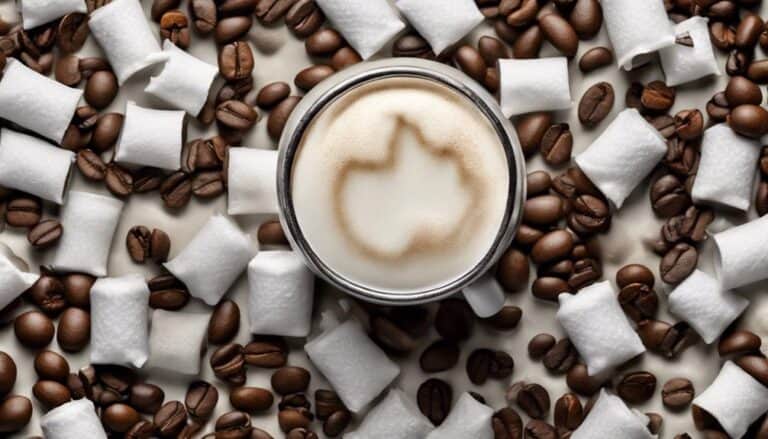The Distinct Differences Between Cappuccino Latte and Macchiato Explained

As we sat down at the quaint café, my friend ordered a cappuccino while I opted for a latte. The barista's deft movements behind the counter piqued our curiosity about the intricate art of crafting these espresso-based beverages.
Each sip revealed subtle nuances that differentiated our choices, prompting a discussion on the distinct differences between cappuccino, latte, and macchiato.
Understanding the unique characteristics of these beloved coffee drinks not only enhances our appreciation for the craft but also helps us navigate the diverse world of espresso-based beverages with informed discernment.
Origins and Cultural Significance
The origins and cultural significance of cappuccino, latte, and macchiato are intricately intertwined with the evolution of coffee consumption practices across different regions and time periods. Cappuccino, named after the Capuchin monks, emerged in Italy during the 1930s. Its frothy milk layer symbolizes the hood of the monks' robes, creating a drink that blends the richness of espresso with the creaminess of milk.
On the other hand, caffè latte, meaning 'milk coffee,' became popular in Europe in the late 19th century. This drink highlights the balance between espresso and steamed milk, offering a smoother and milder flavor profile compared to cappuccino.
Latte macchiato, translating to 'stained milk,' deviates from traditional Italian café culture but has found its place globally. This drink features steamed milk 'stained' with a shot of espresso, creating layers of flavors. Each of these beverages has followed a unique historical timeline of adoption, shaping the diverse landscape of coffee culture across the world.
Ingredients and Flavor Profiles
Having explored the historical origins and cultural significance of cappuccino, latte, and macchiato, we now turn our focus to dissecting the intricate interplay of ingredients and flavor profiles that define these iconic coffee beverages.
Cappuccino, with its equal parts of espresso, steamed milk, and milk foam, offers a rich coffee flavor complemented by a velvety texture. In contrast, latte features a higher ratio of steamed milk to espresso, resulting in a milder taste with a hint of sweetness and a thin layer of foam. Macchiato, on the other hand, presents a stark contrast with a bold and intense coffee flavor due to the minimal milk content, only a splash with espresso.
The distinct flavor profiles in cappuccinos, lattes, and macchiatos are a direct result of the specific ratios of espresso, steamed milk, and foam utilized in each drink. These varying ingredient compositions contribute to the unique tastes and textures that coffee enthusiasts appreciate in each of these beloved beverages.
Ratio and Composition

Exploring the intricate interplay of ratios and compositions in these iconic coffee beverages reveals the nuanced differences in flavor and texture that define cappuccino, latte, and macchiato. Each drink's unique character is a result of the careful balance between espresso, steamed milk, and milk foam.
- Cappuccino: This classic Italian drink boasts a harmonious 1:1:1 ratio of espresso, steamed milk, and milk foam. The equal parts create a bold coffee flavor with a velvety texture, perfect for those who enjoy a balance between espresso and milk.
- Latte: With a ratio of 1:3 for espresso to milk, the latte offers a more subdued coffee taste compared to the cappuccino. The increased milk content provides a creamy mouthfeel, making it a favorite for those seeking a lighter coffee experience.
- Macchiato: Featuring a ratio of 4:1 to 9:1 of espresso to milk, the macchiato packs a punch with its intense coffee flavor. The minimal milk content allows the rich espresso to shine through, delivering a robust and bold taste that appeals to espresso enthusiasts.
Traditional Background and Variations
Amidst the rich tapestry of coffee culture, delving into the traditional backgrounds and nuanced variations of cappuccino, latte, and macchiato unveils a fascinating journey through the evolution of these iconic beverages.
Cappuccino, originating in Italy, pays homage to Capuchin monks and comprises equal parts espresso, steamed milk, and milk foam. On the other hand, latte, with its roots in Europe and the English-speaking world, embodies a ratio of 1/3 espresso, 2/3 steamed milk, and a delicate foam layer.
Macchiato, meaning 'stained milk,' shines through its robust espresso flavor with a small measure of milk, the ratio varying from 4:1 to 9:1 espresso to milk. These drinks have seen unique variations worldwide to accommodate regional preferences, with adjustments made to ingredients, serving sizes, and flavor profiles.
The historical narrative of cappuccinos, lattes, and macchiatos illustrates their adaptation and evolution across diverse cultures and coffee traditions.
Texture and Taste

When considering the texture and taste of cappuccino, latte, and macchiato, it becomes evident that each beverage offers a distinct sensory experience stemming from the precise balance of espresso and milk components.
- Cappuccino: With its rich and velvety texture, cappuccino achieves a harmonious blend of espresso, steamed milk, and milk foam. The foam contributes to a creamy mouthfeel, distinguishing it from other espresso-based drinks.
- Latte: Offering a mild and slightly sweet taste, latte boasts a smoother texture due to a higher ratio of steamed milk to espresso. This balance creates a more delicate flavor profile that appeals to those seeking a gentler coffee experience.
- Macchiato: Known for its intense flavor, macchiato features minimal milk, allowing the boldness of the espresso to shine through. This lack of milk accentuates the robustness and depth of the coffee, appealing to those who prefer a stronger taste sensation.
The unique textures and tastes of cappuccinos, lattes, and macchiatos highlight the art of achieving the perfect balance between espresso and milk, ultimately shaping the overall intensity and sensory delight of each beverage.
Conclusion
In conclusion, the distinct differences between cappuccino, latte, and macchiato lie in their ingredients, ratios, and flavor profiles. Understanding these nuances allows coffee enthusiasts to appreciate the unique qualities of each drink and make informed choices based on their preferences.
Whether you prefer the rich and velvety texture of a cappuccino, the mild and slightly sweet flavor of a latte, or the strong and intense coffee flavor of a macchiato, there's a perfect espresso-based drink for everyone.





